Sony Venice cameras bring cinematic look to sport’s biggest halftime show
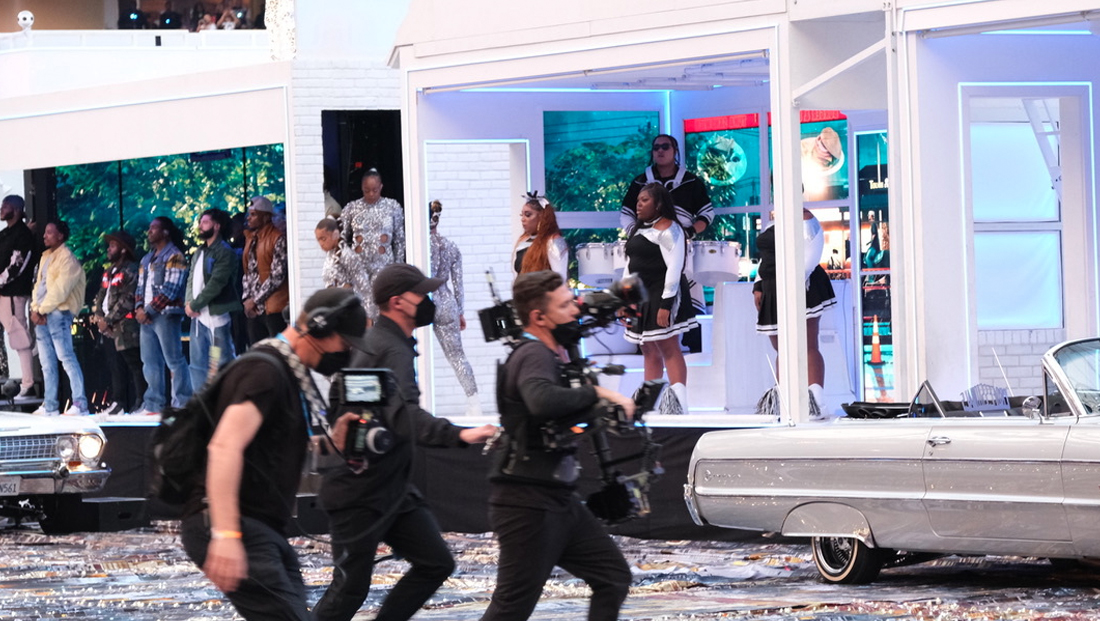
With over 112 million viewers, this year’s Super Bowl Halftime Show lived up to the hype as one of the most-watched in the last five years and it was allow powered by an impressive array of cinematic quality cameras and other gear backed by an adaptable team that had to work within the conditions of a live musical performance.
Produced by Roc Nation, DPS, and Jesse Collins Entertainment, the halftime show took place in Inglewood, California, featuring an all-star lineup including Dr. Dre, Snoop Dogg, Mary J. Blige, Eminem, Kendrick Lamar and 50 Cent.
An array of beautiful cinematic cameras and lenses accompanying state-of-the-art and custom-designed rigging systems, this year’s halftime show proved to be one to remember for not only just the Crib Walk but also the feat of technical complexity.
To create this year’s setting, acclaimed creative director Es Devlin worked with Dr. Dre to design a one-of-a-kind sculpture, inspired by the birthplace of hip hop.
“Both Dre and Jimmy Iovine were drawn more to the studio’s art installation works than the shows. We knew the halftime would be taking place in daylight – which might suit a sculpture or parade more than a light show,” explained Devlin in a statement. “Dre was immediately interested in the idea of ‘placeness’. He sensed that Compton would be another protagonist in the work and that we could etch a map of Compton on the global Super Bowl stage.”
The stage paid homage to the city of Compton, including “Eve’s After Dark,” a nightclub and studio where Dr. Dre honed his craft.
“This show was a celebration of a genre of music that really ignited a cultural change throughout the world,” said Director Hamish Hamilton in the statement. “And given that the Super Bowl was effectively in Compton this year, in a stadium that was built a stone’s throw from where Dre and a huge number of influential music artists spent their formative years, it was crucial for us as a team to do justice to the art of the artists.
The stage was equipped with LED walls that depicted a barber shop, dance club, and served as an artistic interpretation of the famous Compton hangouts where Dre honed his craft.
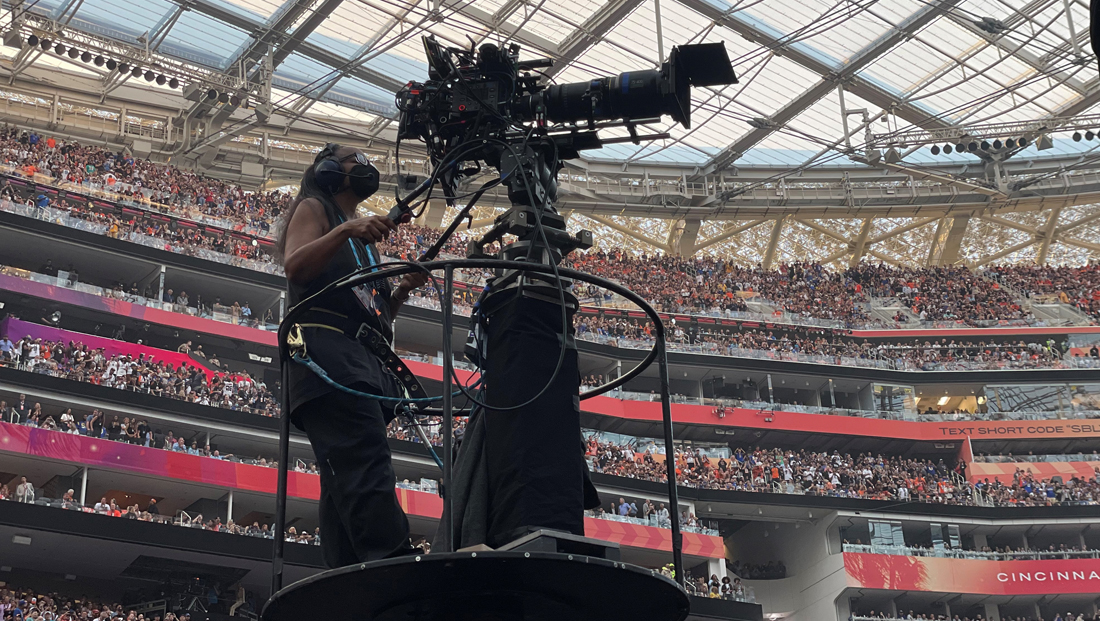
“The details of the buildings are unified by their tone: bone colored (and) shades of stone pale grey — like neon-lit museum pieces — to be remembered as a series of forms and frames for the human story within them,” says Devlin.
While the game itself relied on over 50 broadcast-quality cameras with traditional box lenses, the halftime show relied on 12 Sony Venice cameras, two Sony skycams, and an FX6 for a super wide shot at mid field.
A few factors went into the production’s decision to use Venice units for the first time.
First, there was the challenge of durability because production would be running an entire set on to the field, which hadn’t been done last year with The Weeknd.
As digital cinema cameras are always outfitted with an array of production equipment from lens motors, wireless video systems, and other camera accessories, Hamilton was concerned about the camera’s durability, whether something would fall off the camera and how easily the cameras selected would integrate with the broadcast.
He explains, “This year, we wanted to continue with large format, which would give us those rich cinematic images, a much wider color palette, and a wonderful depth of field. And we wanted to obviously be able to make sure that we could integrate as seamlessly as possible the camera into whatever technology we were going to use to mix and broadcast the show.
“We were using one of the NFL’s control rooms and its media center at SoFi Stadium. We felt for multiple reasons that Sony cameras, and the Venice cameras, would integrate with the live television workflow in a more seamless manner than any other camera brand on the marketplace. Plus, I had used the Venice in a similar workflow a few years ago when we did ‘The Little Mermaid Live’.”
Hamilton also pointed to Dr. Dre’s past work and how hip hop in general has long embraced a more cinematic look.
For him, it made the decision to stick with cinema cameras and lenses that much stronger. “Hip hop has always had a very cinematic approach to it and video making. And certainly, a lot of the projects that Dre has been involved with, and the videos back in the day have always had real epic qualities and cinematic qualities. We wanted to continue that iconography in a way that was appropriate to the genre and to Dre. The large format camera, cinema lenses, it was an absolute no brainer.”
One of the most striking shots of the day was the halftime show’s opening shot — a shot from behind Dr. Dre, which immediately showed the benefits of using a cinema camera, creating a dreamy and epic feel to the open.
Dylan Sanford, the halftime show’s director of photography noted that “we used filtration on one camera for the very first shot: a Smoque 1/4. We liked the blooming and halation it created that made it feel magical. We removed that filter as soon as that very first shot ended. We otherwise kept all the cameras clean.”
While the decision to use large format cinema cameras and lenses was a no brainer, making that plan a reality was not without its difficulties. What started as a plan to use eight Venice cameras which would intercut with existing broadcast cameras, soon evolved to the decision to use only Venice digital cinema cameras.
Hamilton and his team worked with James Coker of Digital Cinema Collective to make the number of cameras work so that the halftime show could maintain the cinematic look and would not have to intercut with traditional broadcast cameras.
To complete the large format cinematic look, the production also leveraged cinema zooms and one specialty box lens by Fujinon which was custom designed to be used with the Venice.
“With some of the handheld cameras, we were changing lenses halfway through, as we went through the 12 minutes, which again, we’ve never done before. But, whenever possible, we tried to get the lens really close to the talent. Obviously, that works with Kendrick’s performance. And we had a couple really great Steadicam moves that we scripted out which really benefited from using the Venice and the lenses.”
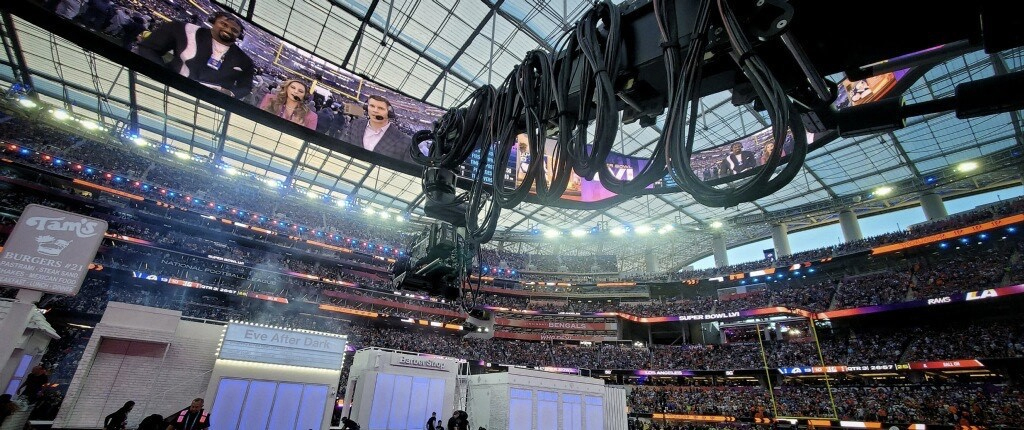
Hamilton and his team worked ahead of time to plan some incredible camera moves and the use of specialty equipment. One of these key decisions was to use a MovieBird 50 Technocrane as a close-up camera, a move he admits he had never tried before.
“All the Eminem stuff was shot with a zoom lens on the end of a Technocrane that we got really close to him,” explains Hamilton. “So, you got that great depth of field and that real proximity with the lens. Which, for a poet like Eminem really worked, because he works well when he performs to a lens close to him. The dynamic between him and (rapper and drummer) Anderson Paak, worked well on that particular shot.”
The team ensured viewers would not see cranes and dollies in the back of each shot. To achieve this, they paid special attention to which lenses they used and which positions they placed them in.
Hamilton explains, “There were some times when we couldn’t put two cameras super close to Mary J. Blige. Otherwise, every time we came wide for the choreography, you would see a giant crane or a Chapman dolly in the frame. We went with a Fujinon zoom so that on her close-up, we got great depth of field. Then, next to that camera, or just below it on the 50, we had the new Fuji long lens. It’s effectively a broadcast lens that Fuji has adapted for the Venice camera. It’s a 4K cinema lens that looks more like a sports box lens than it does a traditional cine lens.”
Using the new Fuji zoom lens on the Venice gave Hamilton’s team a massive zoom range on the 50-yard line. The two cameras became the two-shot on the center and also served as the 45-degree camera when the production was shooting Eminem.
Thanks to one of the fastest first halves in game history, the halftime show took place for the first time in recent history during daylight hours. The show’s bright daylight and the late afternoon sunlight coming through the roof offered some game day challenges.
“The lighting DoP and grading team really had their work cut out as we approached air, because it just wasn’t how we’d ever looked at it through the lens before. However, in some ways, I preferred the show in the daytime to the show that we’d shot many times in the evenings prior. There was just something special and unique about it because you could clearly see the crowd bearing witness. They weren’t hidden in the darkness. There’s a something really beautiful about seeing a crowd of 80,000, all coming together to witness a game of a Super Bowl Halftime,” said Hamilton.
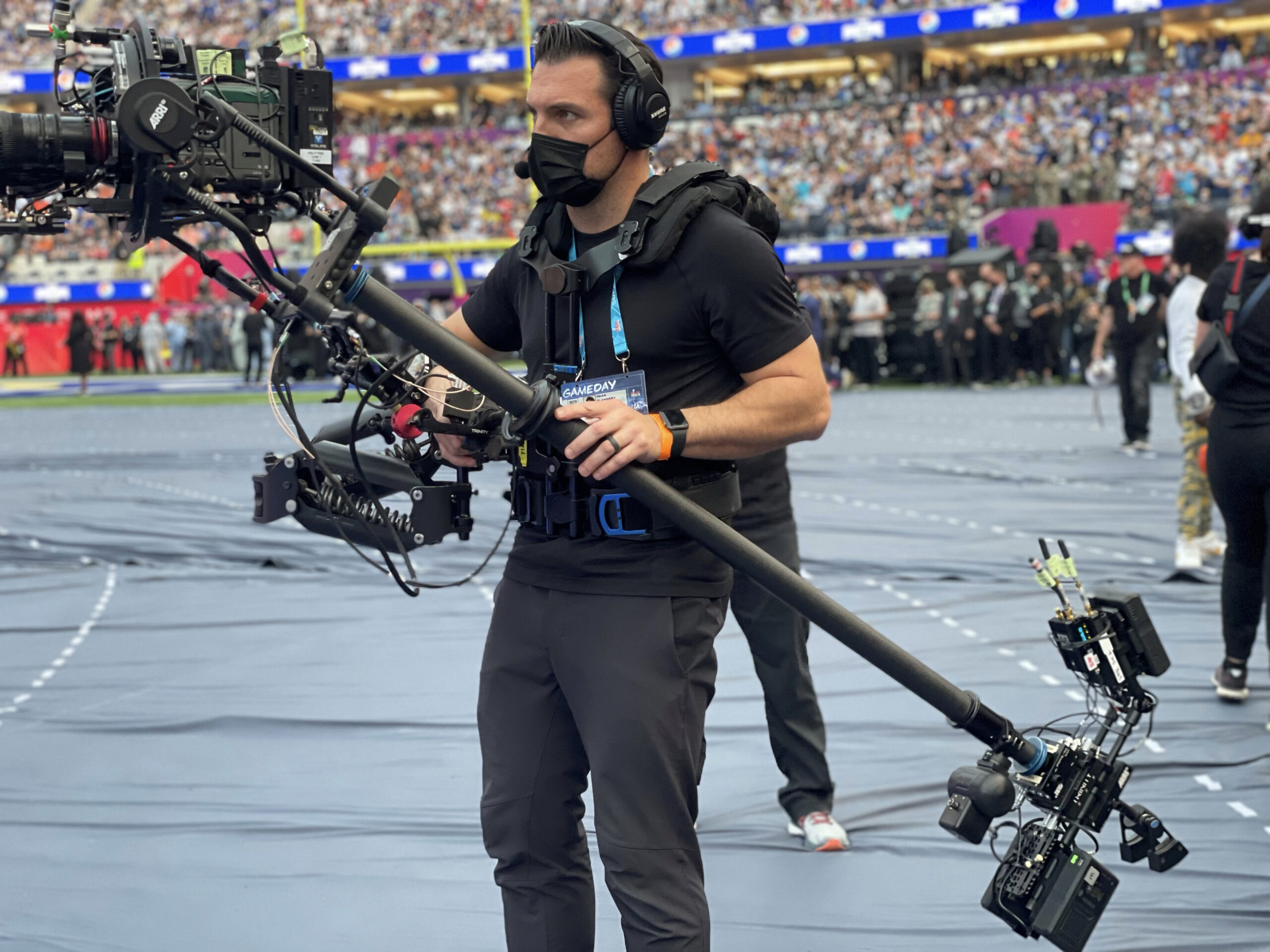
There were some disadvantages to going earlier, but we had no choice. It’s the Super Bowl Halftime, you never know, really, what time you’re going to go. We had to go at five o’clock, so we went at five o’clock. It also meant that we were re-scripting shots live on air. We were taking shots out that we didn’t think would work. Occasionally, you did see something different. We saw a Steadicam operator and we saw a crane in shot that you’d just never seen before, because they were all in the shadows,” Hamilton added.
Another challenge was the bone-colored stage. In a typical broadcast setting, the stage would be blown out or much sharper. But as Hamilton details, the Venice’s color science and dynamic range helped show the detail of the set that Es Devlin had created.
“When we saw the first drawings and renders that (Devlin) came up with, the advantage of the large-format sensor became even more apparent. I think that shooting that on a traditional broadcast camera would really have flattened it out. It would’ve made it much more of a binary experience. The whites would’ve been certainly sharper and I think that what we got from the Venice cameras was a subtlety and, I don’t know, a delicateness. A boldness that you wouldn’t get off a more traditional sports camera. It was a huge advantage, shooting that set on those cameras.”
In addition to doing lens changes and filters, Hamilton’s team also added some other cinematic touches. Among the most notable was the use of a widely discussed bold crash zoom during Kendrick Lamar’s performance.
“Those crash zooms were on a standard Steadicam,” says Hamilton. “They were manually done by the operator, Tore Livia and timed out by the AD, Hayley Collett. That was conceived between my team and Kendrick’s team and Dave Free, who is Kendrick’s creative collaborator.”
Hamilton credits the team who has worked together for years as being the reason for the production’s ability to take bold chances during game day. “There’s a team of people who’ve worked on these shows for many, many years. We know our strengths and weaknesses, and we know what we can and can’t do. We’re constantly trying to develop new skills, new working processes, and embrace new technology in the live — that worked well with the Venice.”
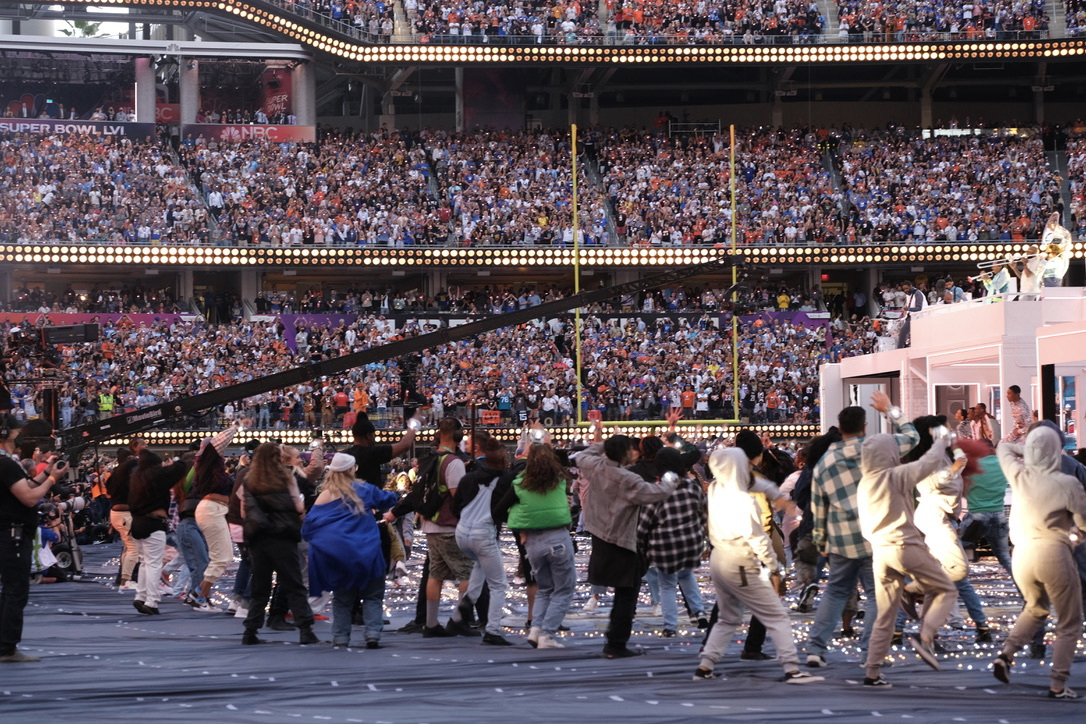
Another successful element were the lights in the audience. “There’s a technology company called PixMob. We put into the stands 70 or 80,000 little necklaces that people could wear. Those necklaces were operated via Bluetooth, and had little lights that can change color. In the night they looked very different than how they did when we shot it. But it gave you a little soft lighting effect, which went with that great depth of field on Mary’s clothes that gave you a little sparkle in the background, which was lovely. Those close ups of Mary are just amazing, that moment when she bends back is just awesome. I loved it. It was absolutely fantastic.”
“I think that the camera technology that we used this year made a huge emotional impact for people watching the show on television. It gave it an aesthetic and an emotion and a cinematic quality that people won’t necessarily have gone, “Oh, they’re shooting that on cinema cameras, aren’t they?” But I think that they will have looked at it and thought, “Wow, this looks epic and special, and has a great sense of occasion. And there’s some great emotion in this, and these guys and Mary J. look iconic and heroic.” That was enhanced by the camera route and the choice of technology. I’m glad that we persevered with a route that was bold, given everything that we had to do in eight minutes.
Photos by Morgan Kellum/PRG
Subscribe to NCS for the latest news, project case studies and product announcements in broadcast technology, creative design and engineering delivered to your inbox.


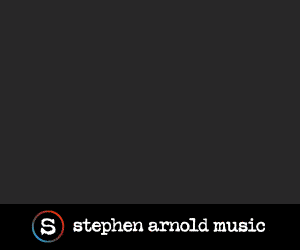


Categories
Broadcast Engineering, Broadcast Industry News, Cameras, Featured, Industry Feed, Sports Broadcasting & Production
The content on this page is provided by the featured companies. NewscastStudio cannot guarantee the accuracy or veracity of any claims about products or services made in this content. The views expressed in this content do not necessarily reflect the views of NewscastStudio or its team. This content may contain trademarks owned by third parties, and those marks are the property of those companies.